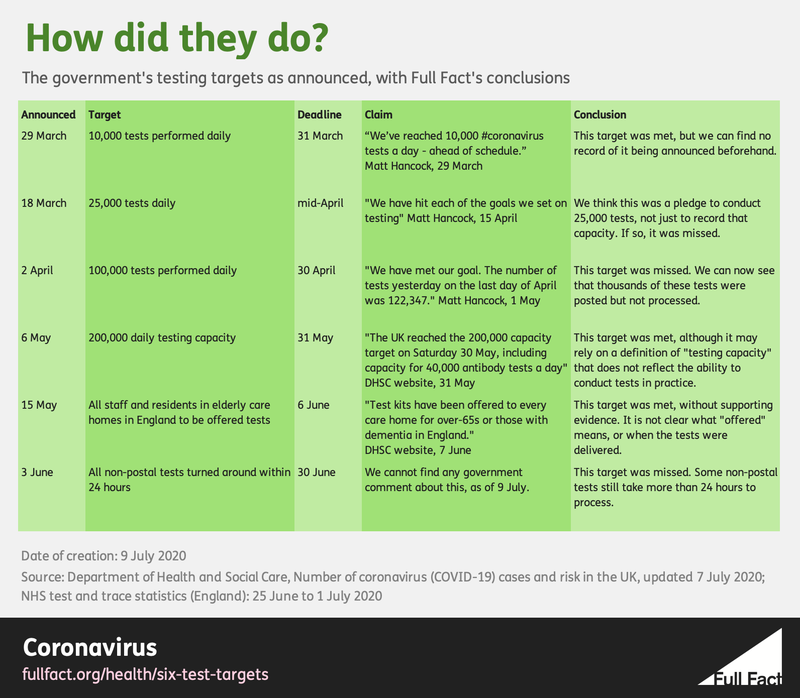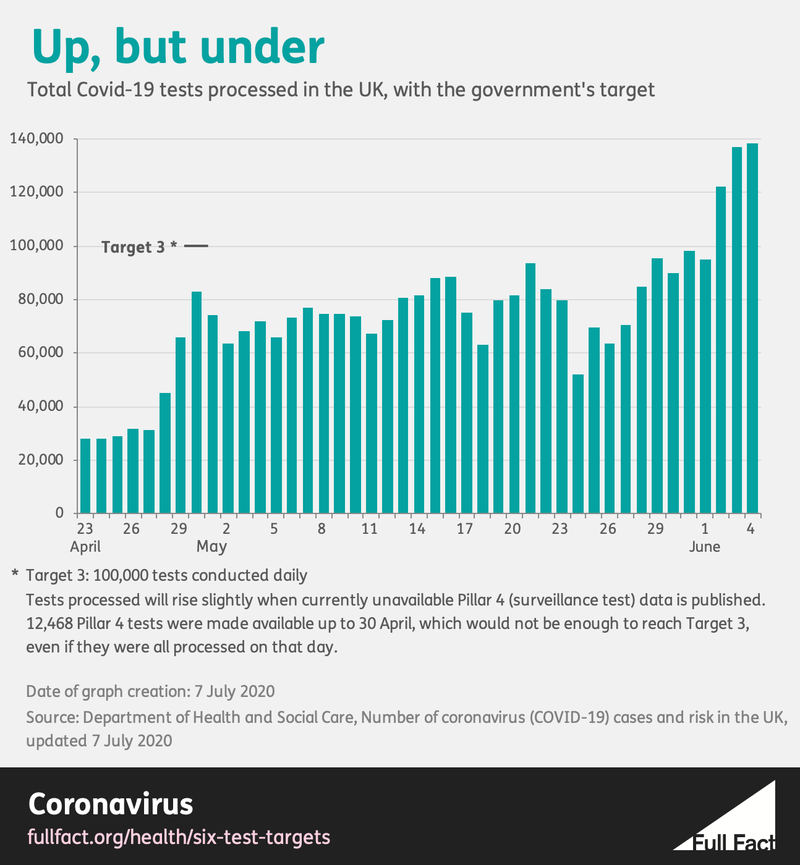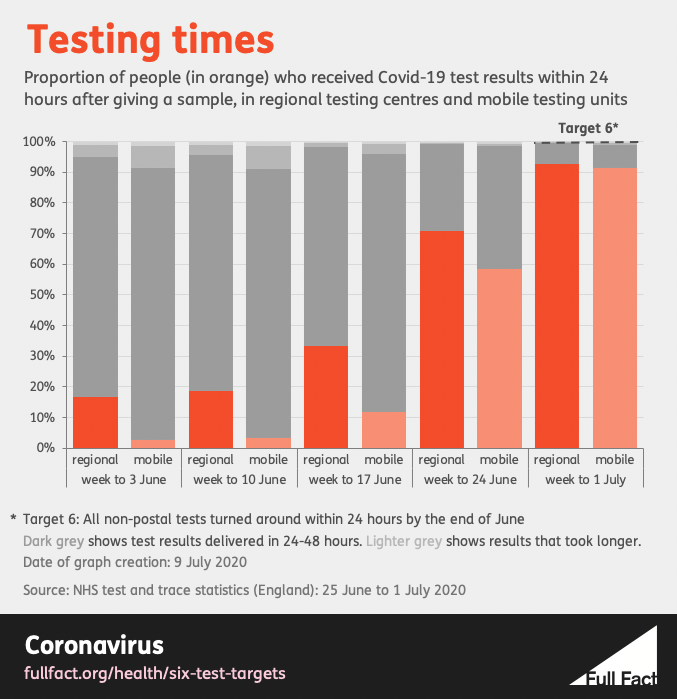Did the government meet its Covid-19 test targets?

Since March, the government has invited the country to judge its progress on these tests by announcing measurable targets. We have written about some of them before, but new data and new targets have since arrived. Here we attempt to describe exactly what was promised, and exactly what happened afterwards. Examining the government’s public statements, we’ve identified six distinct targets so far.
Honesty in public debate matters
You can help us take action – and get our regular free email
Target 1: 10,000 tests performed each day by the end of March
This “target” was met, with a total of 11,896 tests processed on 31 March, according to the latest data at the time of writing. The daily total has remained above 10,000 ever since.
As we have written previously, however, we can find no record of this target actually being announced before 29 March, when the health secretary Matt Hancock tweeted that the government had achieved it. (Although the latest figures do not show tests passing 10,000 until 31 March, two days after his tweet.)
At least twice the government has claimed that it had committed to this target. On 4 April, in the planning document for the testing programme, Mr Hancock said “We have already reached our ambition of 10,000 tests per day by the end of March as we committed.” In response to a journalist’s question during a press briefing on 15 April, he also said “We committed to 10,000 tests by the end of March, which we hit.”
The closest we can find to this commitment is the announcement on 11 March by NHS England that it was ramping up testing with “enhanced labs helping the health service carry out 10,000 tests daily”. This had no deadline attached to it, however, and seemed only to apply to England. Matt Hancock also told parliament on 16 March, “We have already increased the number of tests to 5,000 a day and this is now on its way to 10,000 and then radically further.” Again, he did not mention any deadline.
We have asked the Department of Health and Social Care (DHSC) whether this target was published before 29 March, or whether it was an internal target only. We will update this article if we get an answer.
Even if the target had been announced beforehand, it would not have been possible for the public to judge exactly whether it was met at the time, because data on the number of tests performed did not appear until 6 April.
Target 2: 25,000 tests per day by mid-April
This target was probably missed, although the phrasing of it was imprecise.
In a statement on 18 March, Boris Johnson said “we will massively scale up our testing capacity in the weeks ahead so we hit 25,000 tests a day”.
The exact scope of the target was ambiguous initially. The DHSC announcement of the deadline on the same day said it was a target for “the number of people tested”, or even “hospital patients” in particular, suggesting it was about counting individuals. However the text underneath talked about “the number of tests that can be conducted”, which sounds more like a measure of testing capacity. “The increased capacity is expected to be ready within 4 weeks,” the statement said, which would have meant a deadline on or around 15 April.
At other times, ministers referred to a target of “by mid-April” or “by the end of April at the latest” in relation to the 25,000 figure.
As we have written before, if a time around April 15 was the target for tests conducted then it was not met, although the alternative target of the end of April was. According to government data, 18,489 tests were processed on 15 April. It was not until 23 April that the number exceeded 25,000.
Data for testing capacity was not published until 27 May, so again it would not have been possible to judge at the time whether a capacity target had been met. We can now see that lab capacity for all kinds of tests passed 25,000 on 9 April, reaching 27,057 on that day.
However, as we will discuss later in the article, there remains some uncertainty about how “capacity” is measured, and how meaningful it is if the system is never used at full capacity.

This target was missed, but the government claimed it was achieved.
On 2 April, Matt Hancock said, “I am now setting the goal of 100,000 tests per day, by the end of this month. That is the goal and I am determined that we will get there.”
Later the same day Number 10 tweeted a pledge to “test 100,000 people per day by the end of this month”. Again, this made it unclear whether the pledge was a target for the number of tests carried out, or for the number of people tested.
However on 4 April, a government document on scaling-up the testing programme clearly showed that it was a target for tests conducted. It said: “Other countries are also aiming to conduct 100,000 tests per day - Germany by mid-April, the UK by the end of April and France by the end of June”.
On 1 May, during the daily press briefing, Mr Hancock announced that the target had been reached. As we wrote at the time, this claim rested on a decision to count tests posted out to homes and satellite centres in the same category as tests actually conducted. Mr Hancock and Professor John Newton, who is in charge of the government’s testing programme, have both said this decision was taken under advice because when a test enters the postal system it leaves the control of the testing programme.
This may have made sense for administrative reasons, but posting a test to a patient clearly does not mean that the test has been conducted. Some tests may not arrive, or may not be performed, or may never be returned to a lab for processing. Even those postal tests that are returned correctly will usually take several days after first being posted to produce a result, which is the purpose of the test.
Until the government published revised data on 4 July, it was not possible to see how many tests were actually processed by labs. Using this new data, we can now say that 83,143 tests were processed on 30 April.
This does not include Pillar 4 tests (those used for research and surveillance), because the number that were processed at this time has so far not been published. However, even if all the 12,468 Pillar 4 tests made available up to 30 April had been processed on that day, it would not have been enough to reach this target.
The total number of tests processed in a day did not reach 100,000 until 2 June. With Pillar 4 tests included, it may have been a few days earlier.

This target was met, according to government data, although questions remain about how accurately that reflects capacity in practice.
On 6 May, Mr Johnson said during Prime Minister’s Questions, “Last week, [Keir Starmer] paid tribute to the amazing work of the NHS, the logistics team and everybody involved in getting up from 2,000 tests a day in March to 120,000 by the end of April. Yes, he is right that capacity currently exceeds demand. We are working on that. We are running at about 100,000 a day, but the ambition, clearly, is to get up to 200,000 a day by the end of this month, and then to go even higher.”
Based on his comments this seemed to be a target for 200,000 daily tests conducted by the end of May, but later that day it was reported that the Prime Minister had meant testing capacity. Then in the government’s strategy document on 11 May the target was set out plainly as: “the Government has committed to increase capacity to 200,000 tests per day by the end of May.”
Data for testing capacity began to be published on 27 May, when it showed a total lab capacity of 161,214 tests up to that day. Then on 31 May, DHSC announced that the target had been met the day before, when testing capacity was recorded as 205,634. (We can now see that capacity also exceeded 200,000 on 29 May.)
Most of this was made up of capacity for Pillar 2 tests (those done by commercial companies for the wider public), which include many of the tests delivered by post. Crucially, it also involved the sudden addition, on 29 May, of capacity to process 40,000 Pillar 3 antibody tests each day. (These are the tests which show whether someone has been infected in the past, rather than whether they have the virus in the present.)
Mr Hancock said when he announced the “five pillars” strategy on 2 May that all types of test, including those for antibodies, would be counted towards the earlier 100,000 target. We can’t find anything that suggests otherwise, so we assume this target should be counted in the same way.
Testing capacity continued to exceed tests actually conducted by a very wide margin, however. On 29 May, when total capacity first passed 200,000, less than half of it was being used (although unpublished Pillar 4 data might make up for some of this) . This raises questions about how capacity is measured, and whether the published “lab capacity” really reflects the ability to conduct tests in practice.
In a note on methods , DHSC says that “Projected lab capacity is an estimate of each lab’s constrained capacity each day based on the staff, chemical reagents and other resources it has available.” We have asked whether this definition reflects the whole capacity to conduct a test—including the availability of kits and staff at testing centres, for example—but have not yet received a reply.
Government data shows that labs consistently report the capacity to process far more tests than they actually do. It may be important for labs to have some spare capacity, and it is possible that some postal tests are being stockpiled, meaning that fewer than expected have been returned for processing. Based on what we know, however, it is difficult to be sure that the reported capacity is a meaningful measure of the real capacity to conduct tests.

The government claims that this target was met, but it has not provided evidence to support this.
In its recovery strategy, published on 11 May, the government said, “It is offering a COVID-19 test to every staff member and resident in every care home in England, whether symptomatic or not; by 6 June, every care home for the over 65s will have been offered testing for residents and staff.”
On 15 May, Mr Hancock announced a slightly different version of this target which referred to testing people rather than just offering tests. “We’ll test every resident, and every member of staff in our elderly care homes in England between now and early June. To get those tests to where they need to be, we’ve set up an easy to use digital service on gov.uk, allowing care home managers to apply online for the testing kits.”
DHSC claimed that this target (once again expressed as a commitment to “offer” rather than perform the tests) was met on 7 June. In the process, it claimed that “the government has provided 1,071,103 test kits to 8,984 care homes”.
By looking at data kept by the Care Quality Commission, we think that there are around 10,600 residential care homes in England which are registered to provide a service to “older people”. If these were indeed all eligible for testing kits, then about 1,600 must not have received any—either because they declined the government’s offer, or because the tests were delivered after the deadline, or because the offer wasn’t made.
We cannot find any public data on the number of tests offered or provided to care homes. We have asked DHSC what offering these tests involved, how it was established how many tests each home required, and when the tests themselves were delivered. We have not received an answer.
Target 6: All non-postal tests turned around within 24 hours by the end of June
This target was missed.
At Prime Minister’s Questions on 3 June, Mr Johnson said, “I can undertake to him now to get all tests turned around in 24 hours by the end of June, except for difficulties with postal tests or insuperable problems like that.” DHSC later told us that “Testing times are defined as time taken to process a result from when the sample is provided. That’s what the 24 hour target will focus on.”
On 9 July, the government published data on the turnaround time of Pillar 2 tests. These showed that 91.8% of tests at regional testing sites, and 89.6% of tests at mobile testing units, were turned around within 24 hours. These turnaround times have improved substantially since the Prime Minister set the target, but they have not reached 100%. It is possible that all tests were turned around within 24 hours on some days, but it did not happen consistently throughout the week.
Separate data for Pillar 1 tests (conducted by the health service for staff or those with a clinical need) from NHS England shows that over 90% of labs had an average turnaround time of less than 24 hours by the end of June. This data is not necessarily comparable with the data for Pillar 2.
We therefore cannot say exactly what percentage of non-postal tests were being turned around within 24 hours by the end of last month. We can certainly say, however, that it was not all of them.

Some people claim that the act of setting a target distorts the thing you are trying to measure.
On the other hand, when we asked about their value in May, DHSC told us that “setting a challenging target galvanised government”. Without doubt, the UK’s ability to test people for Covid-19 has increased enormously since March.
It is also important to say that this pandemic requires data to be collected, checked and published much more quickly than in normal times. So it is not surprising that the data by which we judge the government’s targets isn’t perfect, and is still being revised.
However, the government has often been unclear about exactly what its targets were. It has also announced successes without providing evidence that the success was real.
On 2 June, the chair of the UK Statistics Authority, Sir David Norgrove, wrote a letter to Mr Hancock, mentioning several specific problems with the government’s test data. “The aim seems to be to show the largest possible number of tests, even at the expense of understanding,” he said. Full Fact supports Sir David’s letter.
In his response on 12 June, Mr Hancock said: “While standing up the programme and delivering the substance necessary, we have also sought to produce a range of statistics, in a transparent and open way, to allow people to understand what is being delivered. We are inevitably having to work through some challenging issues as the data systems behind these statistics are developed at great pace.” He also said DHSC will continue to engage with the Statistics Authority.